常见化学实验室玻璃仪器
化学实验室常用玻璃仪器及使用

化学实验室常用玻璃仪器及使用1. 烧杯(Beaker):烧杯是一种常见的玻璃容器,形状为圆柱形,通常用于盛装液体、溶液和反应物等物质。
烧杯的使用方法是将待测物质或反应物置于烧杯内,可以加热、加入试剂进行反应、搅拌等操作。
2. 容量瓶(Volumetric Flask):容量瓶是一种用于精确配制溶液的玻璃器皿。
容量瓶的特点是瓶颈较细,足量线以上有一个标定容量,容易判读所配溶液的体积。
使用容量瓶时,应根据需要取相应的溶液量,然后用试剂瓶灌满至足量线,最后用准确定量的方法加入试剂。
3. 量筒(Graduated Cylinder):量筒是用于精确测量液体体积的玻璃仪器。
量筒的体积刻度是沿着筒壁延伸的,并标有刻度,通常以毫升为单位。
使用量筒时,将需要测量的液体缓缓倒入,然后以眼平行刻度线读取液面高度。
4. 试管(Test Tube):试管是一种较长而细的玻璃管,通常用于容纳少量试液进行试验、进行加热反应等。
试管一般可用火焰加热,在进行反应时可以加入试剂进行观察。
5. 滴定管(Burette):滴定管是一种用于定量投加试剂的玻璃仪器,通常用于酸碱滴定等试验中。
滴定管上设有刻度线,可以准确地读取所需投加的溶液体积。
使用滴定管时,先用洗涤液洗净滴定管,然后倒入所要滴定的溶液, tilting the burette to adjust the initial volume to zero or a certain value.6. 分液漏斗(Separatory Funnel):分液漏斗是一种用于将两种不溶液体分离的器皿。
分液漏斗通常呈漏斗状,底部有特殊的球形阀门,用于控制液体的流出速度。
使用分液漏斗时,将需要分离的液体倒入漏斗中,并轻轻摇晃,让两种液体充分接触、分离。
7. 转化瓶(Erlenmeyer Flask):转化瓶是一种具有锥形底部和长颈口的玻璃瓶,通常用于混合和放置试剂、反应产物等物质。
转化瓶的底部形状可以使液体充分搅拌,另外,其长颈口可以减少蒸发和液体的溢出。
化学实验室玻璃仪器

化学实验室玻璃仪器化学实验室是进行化学研究和实验的场所,其中使用的仪器设备是化学实验的基础工具。
在化学实验室中,玻璃仪器是最常用的工具之一。
玻璃仪器作为化学实验常用仪器,具有透明、耐腐蚀、耐高温、不导电等特性,可以用于反应、储存、分离、测量等多种化学实验操作。
以下是常用的化学实验室玻璃仪器及其使用方法。
一、容量瓶容量瓶是一种用于精确测量和调配液体体积的玻璃容器。
按容积可分为5ml、10ml、25ml、50ml、100ml、250ml、500ml、1000ml等多种规格。
一般用来盛放静置不易受振荡的药品或液体,并在容积瓶中药品稀释和分配时,通常使用“调节容积法”。
即:用均匀性好的药品勺或钢筋将药品装入容积瓶中定量计算后,再用滴管夹具滴加蒸馏水或其他合适的溶剂,滴至液位达到刻度线后,插上胶塞振荡均匀,使药品和溶剂、蒸馏水充分混合。
二、分液漏斗分液漏斗是一种用于分离两种不相溶液体的装置。
其结构特点是滴口较长且肥大,并在漏斗底部装有小滴管。
如若分离的两种溶液密度相近,可引用法中转漏斗进行分离。
操作方法是,先将混合液体加入到转漏斗的漏斗口,然后转动漏斗,使其中一种液体流入小管,分离出来。
分离干净后,在小管中间的“大”口外面围上纸杯,倾斜漏斗,可将液体滴入纸杯中去。
三、烧杯烧杯是一种常见的实验室用玻璃器皿,是用来盛放化学试剂,进行加热反应等操作的常用器皿。
杯子的直径为较小端口,底部较厚;较大的侧壁以及较宽的口部有利于放大反应面积。
操作时,首先将需要称量的物质倒入烧杯中,然后进行加热;加热时,应离开炉火,不要过度加热,以免物质溅出,并要不断搅拌,使反应均匀。
使用前需检查烧杯是否有裂纹或破损,以免运用过程中破裂。
四、试管试管是实验室常用的基本器皿之一,由玻璃制成,分直桶试管和弯漏斗试管。
试管一般用于化学试剂的混合、搅拌以及进行常温反应、短时加热等。
操作时注意防滑,不可将试管握得太硬,避免破碎。
在放入液体时,适量装填试管,严禁超载,以免基础件破裂。
化学实验室常用玻璃仪器及使用

比色、比浊分析
不可直火加热;非标准磨口塞必须原配;注意保持管壁透明,不可用去污粉刷洗
冷凝管:直形球形蛇形空气冷凝管
用于冷却蒸馏出的液体,蛇形管适用于冷凝低沸点液体蒸汽,空气冷凝管用于冷凝沸点150℃以上的液体蒸汽
不可聚冷聚热;注意从下口进冷却水,上口出水
抽滤瓶
抽滤时接受滤液
属于厚壁容器,能耐负压;不可加热
只有活塞式;其余注意事项同上
自动滴定管
自动滴定;可用于滴定液需隔绝空气的操作
除有与一般的滴定管相同的要求外,注意成套保管,另外,要配打气用双连球
移液管
准确地移取一定量的液体
不能加热;上端和尖端不可磕破刻度吸管Leabharlann 准确地移取各种不同量的液体
同上
称量瓶
矮形用作测定干燥失重或在烘箱中烘干基准物;高形用于称量基准物、样品
量瓶
配制准确体积的标准溶液或被测溶液
非标准的磨口塞要保持原配;漏水的不能用;不能在烘箱内烘烤,不能用直火加热,可水浴加热
滴定管2550100ml
容量分析滴定操作;分酸式、碱式
活塞要原配;漏水的不能使用;不能加热;不能长期存放碱液;碱式管不能放与橡皮作用的滴定液
微量滴定管
1234510ml
微量或半微量分析滴定操作
垂熔玻璃漏斗
过滤
必须抽滤;不能聚冷聚热;不能过滤氢氟酸、碱等;用毕立即洗净
垂熔玻璃坩埚
重量分析中烘干需称量的沉淀
同上
标准磨口组合仪器
有机化学及有机半微量分析中制备及分离
磨口处勿需涂润滑剂;安装时不可受歪斜压力;要按所需装置配齐购置
不可盖紧磨口塞烘烤,磨口塞要原配
试剂瓶:细口瓶、广口瓶、下口瓶
细口瓶用于存放液体试剂;广口瓶用于装固体试剂;棕色瓶用于存放见光易分解的试剂
化学实验室的必备设备
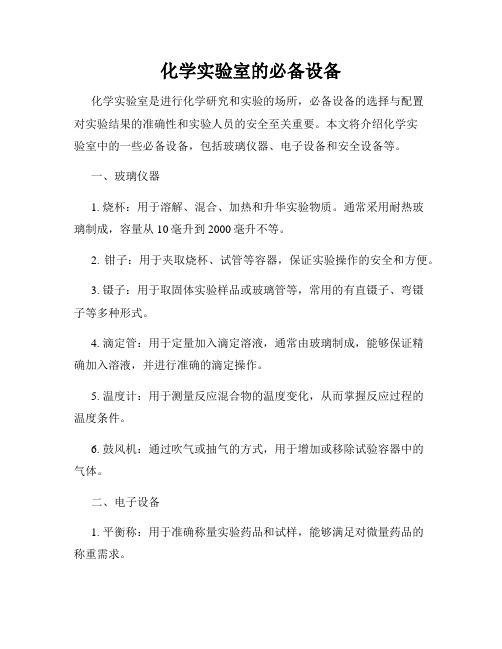
化学实验室的必备设备化学实验室是进行化学研究和实验的场所,必备设备的选择与配置对实验结果的准确性和实验人员的安全至关重要。
本文将介绍化学实验室中的一些必备设备,包括玻璃仪器、电子设备和安全设备等。
一、玻璃仪器1. 烧杯:用于溶解、混合、加热和升华实验物质。
通常采用耐热玻璃制成,容量从10毫升到2000毫升不等。
2. 钳子:用于夹取烧杯、试管等容器,保证实验操作的安全和方便。
3. 镊子:用于取固体实验样品或玻璃管等,常用的有直镊子、弯镊子等多种形式。
4. 滴定管:用于定量加入滴定溶液,通常由玻璃制成,能够保证精确加入溶液,并进行准确的滴定操作。
5. 温度计:用于测量反应混合物的温度变化,从而掌握反应过程的温度条件。
6. 鼓风机:通过吹气或抽气的方式,用于增加或移除试验容器中的气体。
二、电子设备1. 平衡称:用于准确称量实验药品和试样,能够满足对微量药品的称重需求。
2. 恒温槽:用于控制实验环境的温度,对于一些需要保持恒温条件的实验尤为重要。
3. 恒温培养箱:用于控制实验样品的温度和湿度,保证实验的稳定性和可重复性。
4. 离心机:用于沉降分离试验样品,例如细胞、DNA和蛋白质等。
5. 光谱仪:用于测量物质的光谱特性,包括紫外可见光谱仪、红外光谱仪和质谱仪等。
三、安全设备1. 实验台:用于放置实验器皿和实验试剂,设计要合理、结构稳固。
2. 实验室柜:用于储存危险化学品和试剂,保证实验室的安全性和环境卫生。
3. 紧急淋浴器和洗眼器:用于应对实验人员发生化学品溅入眼睛或身体等急需冲洗的情况。
4. 通风设备:用于保持实验室空气质量的良好,并排除实验过程中产生的有害气体。
5. 灭火器:用于灭火,保障实验室的火灾安全。
化学实验室的必备设备在实验过程中起到了至关重要的作用。
这些设备既保证了实验的准确性和可重复性,又保障了实验人员的安全。
因此,在化学实验室中正确使用和配置这些设备是非常重要的。
此外,定期对这些设备进行维护和保养,确保其正常运行和安全使用,也是实验室管理的重要环节。
初中化学实验室仪器设备大全

初中化学实验室仪器设备大全化学实验是初中化学课程的重要组成部分,而化学实验室的仪器设备则是保证实验顺利进行的关键。
本文将介绍一些常见的初中化学实验室仪器设备,帮助同学们更好地了解和使用这些设备。
1.实验室玻璃器皿实验室中最常见的器皿之一就是玻璃器皿。
玻璃烧杯、砂芯漏斗、试管、瓶口脱硅器等都是常用的玻璃器皿。
它们由于具有很好的透明性、耐热性和化学稳定性,被广泛应用于化学实验中。
2.量筒、量瓶和容量瓶量筒、量瓶和容量瓶是用来精确测量液体体积的工具。
量筒适用于体积较大的液体测量,量瓶适用于较小的液体测量,而容量瓶则适用于较为精确的容积测量。
3.温度计和热水浴温度计用于测量液体或气体的温度,常见的有普通温度计和数字温度计两种。
而热水浴则是用来保持反应体系的恒温环境,使实验结果更加准确。
4.酒精灯和点燃器酒精灯是一种用酒精作为燃料的灯具,常用于加热试管、烧杯等实验用具。
而点燃器则用于点燃酒精灯等工具,以方便进行实验。
5.PH试纸和PH仪PH试纸是用来测量溶液酸碱度的工具,通过比较试纸的颜色变化来判断溶液的PH值。
而PH仪是一种更加精确的酸碱度测量仪器,可以直接显示溶液的PH 值。
6.实验室天平和称量瓶实验室天平用于精确称量固体物质的质量,常见的有电子天平和梁平两种。
而称量瓶则是一种带有刻度的容器,可以精确称取一定体积的液体。
7.集气瓶和导管集气瓶是用来收集气体的容器,常见的有圆底集气瓶和倒挂瓶两种。
导管则是用来导引气体的工具,常见的有玻璃导管和橡胶导管两种。
8.过滤器和漏斗过滤器和漏斗是用来进行固液分离的工具。
过滤器可以将固体颗粒从液体中分离出来,常见的有纸过滤器和玻璃棉过滤器。
漏斗则可以用于将液体从一个容器倾倒到另一个容器,常用于过滤操作中。
9.反应管和烧杯反应管是用来进行化学反应的容器,常见的有试管和石棉网支撑的燃烧管。
烧杯则是一种带有刻度的容器,常用于加热和混合反应溶液。
10.恒温槽和恒温培养箱恒温槽和恒温培养箱是用来保持固定温度环境的设备。
常用玻璃仪器的使用及注意事项
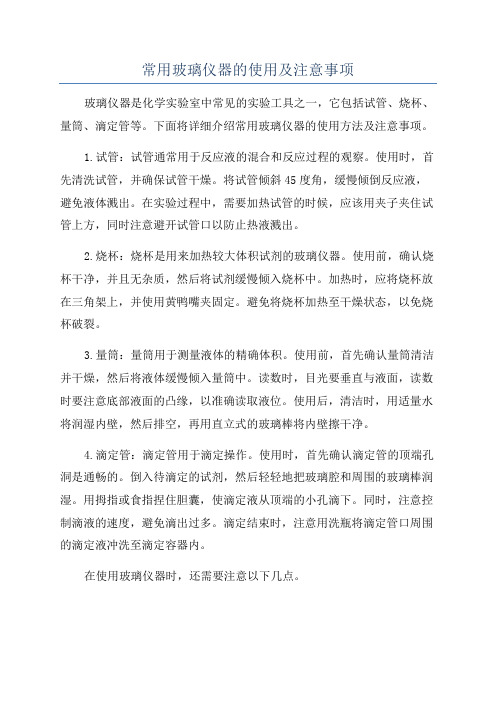
常用玻璃仪器的使用及注意事项玻璃仪器是化学实验室中常见的实验工具之一,它包括试管、烧杯、量筒、滴定管等。
下面将详细介绍常用玻璃仪器的使用方法及注意事项。
1.试管:试管通常用于反应液的混合和反应过程的观察。
使用时,首先清洗试管,并确保试管干燥。
将试管倾斜45度角,缓慢倾倒反应液,避免液体溅出。
在实验过程中,需要加热试管的时候,应该用夹子夹住试管上方,同时注意避开试管口以防止热液溅出。
2.烧杯:烧杯是用来加热较大体积试剂的玻璃仪器。
使用前,确认烧杯干净,并且无杂质,然后将试剂缓慢倾入烧杯中。
加热时,应将烧杯放在三角架上,并使用黄鸭嘴夹固定。
避免将烧杯加热至干燥状态,以免烧杯破裂。
3.量筒:量筒用于测量液体的精确体积。
使用前,首先确认量筒清洁并干燥,然后将液体缓慢倾入量筒中。
读数时,目光要垂直与液面,读数时要注意底部液面的凸缘,以准确读取液位。
使用后,清洁时,用适量水将润湿内壁,然后排空,再用直立式的玻璃棒将内壁擦干净。
4.滴定管:滴定管用于滴定操作。
使用时,首先确认滴定管的顶端孔洞是通畅的。
倒入待滴定的试剂,然后轻轻地把玻璃腔和周围的玻璃棒润湿。
用拇指或食指捏住胆囊,使滴定液从顶端的小孔滴下。
同时,注意控制滴液的速度,避免滴出过多。
滴定结束时,注意用洗瓶将滴定管口周围的滴定液冲洗至滴定容器内。
在使用玻璃仪器时,还需要注意以下几点。
1.清洁:玻璃仪器在使用前后应进行清洁。
可以用肥皂水或生物洗涤剂洗涤,然后用清水冲洗干净。
避免使用有机溶剂,因为它们可能污染仪器。
2.干燥:清洗后的玻璃仪器应该放在通风处晾干,避免将水滴残留在仪器上。
对于一些需要用到无尘环境的仪器,可以用气枪或熔融蓝心过滤器进行干燥。
3.存放:玻璃仪器在存放时,应该放在干燥、清洁、无振动的地方,避免碰撞和破损。
可以用干洁的白纸或布将其包裹,以防尘和损坏。
4.使用注意:在使用玻璃仪器时,要小心轻放,避免碰撞和破损。
特别是对于发现有破损或者缺陷的玻璃仪器,应立即停止使用并更换。
常用的化学仪器及名称图 整理
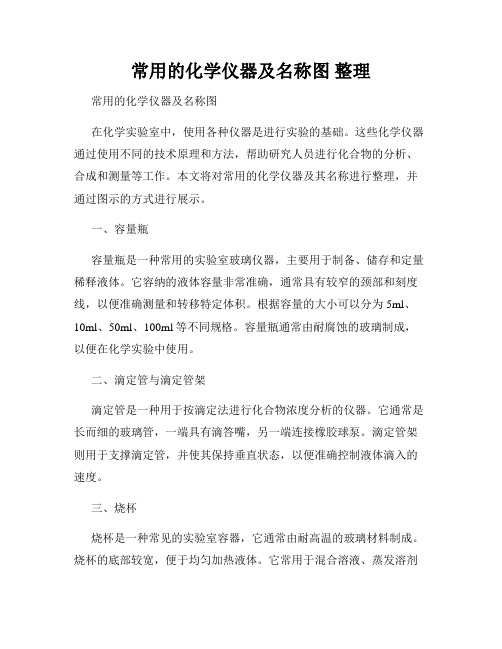
常用的化学仪器及名称图整理常用的化学仪器及名称图在化学实验室中,使用各种仪器是进行实验的基础。
这些化学仪器通过使用不同的技术原理和方法,帮助研究人员进行化合物的分析、合成和测量等工作。
本文将对常用的化学仪器及其名称进行整理,并通过图示的方式进行展示。
一、容量瓶容量瓶是一种常用的实验室玻璃仪器,主要用于制备、储存和定量稀释液体。
它容纳的液体容量非常准确,通常具有较窄的颈部和刻度线,以便准确测量和转移特定体积。
根据容量的大小可以分为5ml、10ml、50ml、100ml等不同规格。
容量瓶通常由耐腐蚀的玻璃制成,以便在化学实验中使用。
二、滴定管与滴定管架滴定管是一种用于按滴定法进行化合物浓度分析的仪器。
它通常是长而细的玻璃管,一端具有滴答嘴,另一端连接橡胶球泵。
滴定管架则用于支撑滴定管,并使其保持垂直状态,以便准确控制液体滴入的速度。
三、烧杯烧杯是一种常见的实验室容器,它通常由耐高温的玻璃材料制成。
烧杯的底部较宽,便于均匀加热液体。
它常用于混合溶液、蒸发溶剂和加热试剂等操作。
烧杯一般具有不同容量,如100ml、250ml、500ml等。
四、试管与试管架试管是一种常用的实验室玻璃仪器,形状类似细长的圆柱体,一端开放,另一端封闭。
试管通常用于混合和加热液体,以及进行小规模试验。
试管架则用于支撑试管,使其垂直放置,并便于进行观察和操作。
五、显微镜显微镜是一种用于观察小尺寸物体的仪器,广泛应用于生物学、化学和材料科学等领域。
显微镜通过聚焦光线来放大物体的细节,使人们能够观察微小的结构和颗粒。
常见的显微镜包括光学显微镜和电子显微镜等。
六、离心机离心机是一种常见的实验室仪器,用于将混合液体中的物质分离。
它利用离心力的作用,将物质分离成不同的层,便于进行分析和研究。
离心机通常具有不同的转速和容量,以适应不同的实验需求。
七、分光光度计分光光度计是一种用于测量物质溶液中光的吸收和透射的仪器。
分光光度计利用光的特性来分析溶液中的物质浓度和反应速率等。
有机化学玻璃仪器介绍
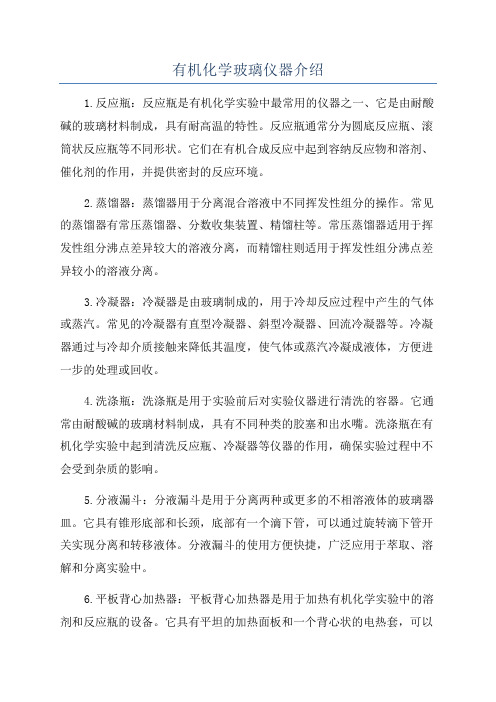
有机化学玻璃仪器介绍1.反应瓶:反应瓶是有机化学实验中最常用的仪器之一、它是由耐酸碱的玻璃材料制成,具有耐高温的特性。
反应瓶通常分为圆底反应瓶、滚筒状反应瓶等不同形状。
它们在有机合成反应中起到容纳反应物和溶剂、催化剂的作用,并提供密封的反应环境。
2.蒸馏器:蒸馏器用于分离混合溶液中不同挥发性组分的操作。
常见的蒸馏器有常压蒸馏器、分数收集装置、精馏柱等。
常压蒸馏器适用于挥发性组分沸点差异较大的溶液分离,而精馏柱则适用于挥发性组分沸点差异较小的溶液分离。
3.冷凝器:冷凝器是由玻璃制成的,用于冷却反应过程中产生的气体或蒸汽。
常见的冷凝器有直型冷凝器、斜型冷凝器、回流冷凝器等。
冷凝器通过与冷却介质接触来降低其温度,使气体或蒸汽冷凝成液体,方便进一步的处理或回收。
4.洗涤瓶:洗涤瓶是用于实验前后对实验仪器进行清洗的容器。
它通常由耐酸碱的玻璃材料制成,具有不同种类的胶塞和出水嘴。
洗涤瓶在有机化学实验中起到清洗反应瓶、冷凝器等仪器的作用,确保实验过程中不会受到杂质的影响。
5.分液漏斗:分液漏斗是用于分离两种或更多的不相溶液体的玻璃器皿。
它具有锥形底部和长颈,底部有一个滴下管,可以通过旋转滴下管开关实现分离和转移液体。
分液漏斗的使用方便快捷,广泛应用于萃取、溶解和分离实验中。
6.平板背心加热器:平板背心加热器是用于加热有机化学实验中的溶剂和反应瓶的设备。
它具有平坦的加热面板和一个背心状的电热套,可以通过电源的控制来调节加热温度。
平板背心加热器在有机化学合成实验中起到加热反应溶液的作用,提高反应速率和反应产率。
7.真空干燥器:真空干燥器是用于去除有机化学实验中溶剂中的水分和其他杂质的设备。
它由玻璃制成,具有特殊的密封装置,可以形成高真空环境。
真空干燥器通常用于干燥空气敏感的有机化合物,并保持它们的纯度和稳定性。
以上介绍的仅是有机化学实验室中常见的几种玻璃仪器,当然还有其他更多种类的仪器设备,如萃取器、干燥管等。
这些仪器设备的使用与操作需要遵循相关的安全规范和实验操作规程,以确保实验的安全和结果的准确性。
化学实验室常用玻璃仪器及使用

化学实验室常用玻璃仪器及使用1. 烧杯(Beaker):烧杯是一种常见的容器,形状为圆柱形,底部较宽。
它主要用于盛放液体、搅拌物质和进行少量的加热。
使用时,将待盛放的液体或溶液倒入烧杯中,可以通过刻度线判断体积,根据需要可以进行加热、搅拌等操作。
2. 烧瓶(Flask):烧瓶是一种颈部较长的容器,形状为圆底或扁底。
它主要用于制备溶液、蒸馏、回流等操作。
使用时,将待制备的溶液或反应物倒入烧瓶中,可以通过刻度线判断体积,根据需要可以连接其他器材进行蒸馏、回流等操作。
3. 试管(Test tube):试管是一种较小的圆筒形容器,通常用于小规模试验和储存少量物质。
使用时,将待操作物质倒入试管中,可以通过刻度线判断体积,可以通过加热、搅拌等操作进行实验。
4. 显微镜片(Microscope slide):显微镜片是一种长方形的平板,用于放置待观察的样品。
在化学实验中,显微镜片通常用于观察晶体结构、显微镜下的实验等。
使用时,将待观察的样品放在显微镜片上,通过显微镜放大观察。
5. 滴定管(Burette):滴定管是一种具有刻度的玻璃管,用于定量滴定,测量溶液的体积。
滴定管具有放置液体的储液器和滴液的流通管道,通过旋塞控制液体的流量和滴定过程。
使用时,打开旋塞,将待滴定的试剂滴入容器中,直到滴定终点出现颜色变化,记录滴定所用的体积,根据所需计算出待测溶液的浓度或反应物之间的摩尔比。
6. 双口胶头滴管(Dropping pipette):双口胶头滴管是一种玻璃仪器,通常用于降低溶液的浓度、调整pH值、标定浓度等。
使用时,将需要的试剂吸入滴管中,通过挤压滴管胶头使溶液缓慢地滴入反应容器。
除了上述常见的玻璃仪器,化学实验室中还有许多其他的玻璃仪器,如试剂瓶、漏斗、生物反应器、取样针等。
每一种仪器都有着特定的用途和使用方法。
在进行化学实验时,需要根据实验的目的和要求选择合适的玻璃仪器,并且要正确使用和操作,以确保实验的准确性和安全。
初中化学实验室仪器设备一览表
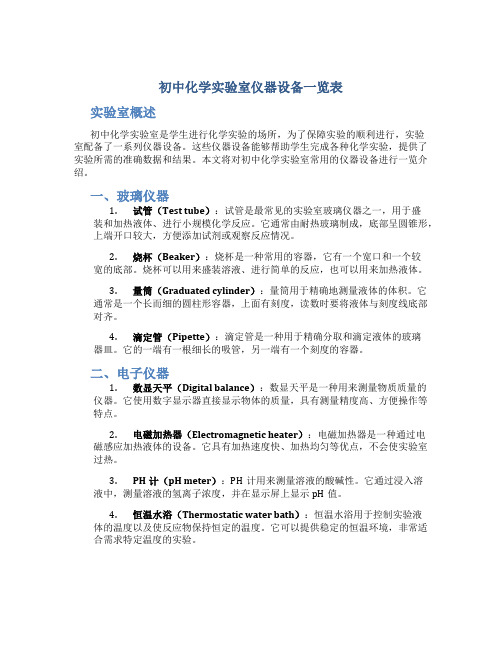
初中化学实验室仪器设备一览表实验室概述初中化学实验室是学生进行化学实验的场所,为了保障实验的顺利进行,实验室配备了一系列仪器设备。
这些仪器设备能够帮助学生完成各种化学实验,提供了实验所需的准确数据和结果。
本文将对初中化学实验室常用的仪器设备进行一览介绍。
一、玻璃仪器1.试管(Test tube):试管是最常见的实验室玻璃仪器之一,用于盛装和加热液体、进行小规模化学反应。
它通常由耐热玻璃制成,底部呈圆锥形,上端开口较大,方便添加试剂或观察反应情况。
2.烧杯(Beaker):烧杯是一种常用的容器,它有一个宽口和一个较宽的底部。
烧杯可以用来盛装溶液、进行简单的反应,也可以用来加热液体。
3.量筒(Graduated cylinder):量筒用于精确地测量液体的体积。
它通常是一个长而细的圆柱形容器,上面有刻度,读数时要将液体与刻度线底部对齐。
4.滴定管(Pipette):滴定管是一种用于精确分取和滴定液体的玻璃器皿。
它的一端有一根细长的吸管,另一端有一个刻度的容器。
二、电子仪器1.数显天平(Digital balance):数显天平是一种用来测量物质质量的仪器。
它使用数字显示器直接显示物体的质量,具有测量精度高、方便操作等特点。
2.电磁加热器(Electromagnetic heater):电磁加热器是一种通过电磁感应加热液体的设备。
它具有加热速度快、加热均匀等优点,不会使实验室过热。
3.PH计(pH meter):PH计用来测量溶液的酸碱性。
它通过浸入溶液中,测量溶液的氢离子浓度,并在显示屏上显示pH值。
4.恒温水浴(Thermostatic water bath):恒温水浴用于控制实验液体的温度以及使反应物保持恒定的温度。
它可以提供稳定的恒温环境,非常适合需求特定温度的实验。
三、其他仪器1.分液漏斗(Separatory funnel):分液漏斗主要用于在溶液中进行液液分离。
它通常是一个锥形的玻璃器皿,上部有一个粗长的喇叭口,可以将两种不可混合的液体分离开来。
化学实验室中常用的玻璃仪器和操作技巧

化学实验室中常用的玻璃仪器和操作技巧为了能够准确、高效地进行化学实验,熟悉和正确运用各种玻璃仪器是必不可少的。
本文将介绍化学实验室中常用的一些玻璃仪器以及相关的操作技巧,希望能够对化学实验工作者有所帮助。
一、烧杯(Beaker)烧杯是一种常用的容器,主要用于溶解、搅拌、加热等操作。
它具有较大的底部面积,便于反应液的混合和加热。
烧杯一般通过标线来确定容量,使用时应留意不要过量倒液,以免溢出。
同时,烧杯通常需要放在三角架上进行加热,以免直接接触火焰,导致破裂。
二、容量瓶(Volumetric Flask)容量瓶是一种用于准确配制溶液的仪器。
容量瓶具有较细的口部和长颈设计,以防止溶液的蒸发和溢出。
它的顶部有一根长长的喉管,用于调节液面至标线。
在配制溶液时,首先添加适量试剂,然后倒入溶剂至接近标线的位置,最后用吸管吹去喉管处的余液,使液面准确到达标线位置。
三、试管(Test Tube)试管是一种用于小规模反应、加热和观察的玻璃仪器。
试管通常较小,直径较细,底部稍微膨胀,且不带盖子。
在使用试管进行加热时,应将试管倾斜放置,避免液体沸腾喷溅和试管爆炸。
四、量筒(Graduated Cylinder)量筒是一种用于准确测量液体体积的仪器。
量筒的设计使其具有清晰的刻度,通常可以在毫升级别下测量。
在使用量筒时,应注意垂直读数,将眼睛放置在液面与刻度线相同高度处,以减少读数误差。
五、滴定管(Pipette)滴定管是一种用于准确移取和释放液体的仪器。
滴定管分为体积式和容量式两种。
体积式滴定管通常用于测量某种液体的体积,容量式滴定管用于定量移液。
在操作滴定管时,应注意使用吸球或电子吸引器,保持嘴部处于滴定液的底部,并控制滴定速度。
六、分液漏斗(Separatory Funnel)分液漏斗是一种用于分离两种或多种不相溶液体的仪器。
在使用分液漏斗时,应先开启放液口,使部分液体滴入容器中,然后关闭放液口,摇晃分液漏斗使两种液体完全分离,再次开启放液口释放下层液体。
初中化学实验室常见的化学仪器

初中化学实验室常见的化学仪器1. 烧杯(Beaker)烧杯是实验室中最常见的玻璃器皿之一,它具有圆筒形状和平底,通常用来容纳溶液、反应物或者废弃物质。
烧杯有不同的容量,可以根据需要选择不同的大小。
在实验中,烧杯经常与玻璃棒或者试管夹配合使用,用于搅拌溶液或者将液体转移至其他容器。
2. 试管(Test Tube)试管是圆筒形的玻璃容器,通常由耐热玻璃制成。
试管具有较小的直径和较长的长度,可用于加热或存储小量液体。
在实验室中,试管通常用来进行小规模的试验或者观察物质在不同条件下的反应。
3. 集气瓶(Gas Jar)集气瓶是用来收集气体的容器,常见的集气瓶是由玻璃制成,底部略呈锥形。
在化学实验中,当需要收集一定量的气体时,可以使用集气瓶。
使用集气瓶时,首先将其倒置在水槽或水池中,然后将气体导入瓶内,气体会顶出水从而被收集。
4. 分液漏斗(Separatory Funnel)分液漏斗是实验室中进行液体分层或分离的常用工具。
分液漏斗外形呈锥形,底部有一个窄细的出口,通常可以用橡胶塞或者石蜡封闭。
通过调节漏斗的角度,不同密度的液体可以分层并通过底部出口分别收集。
5. 显微镜(Microscope)显微镜是用来放大观察微小物体的仪器。
在化学实验室中,显微镜通常用于观察物质的微观结构、晶体的形态以及其他微小颗粒。
显微镜分为光学显微镜和电子显微镜两种类型,其中光学显微镜可见光成像,电子显微镜则利用电子束成像。
6. 温度计(Thermometer)温度计用于测量物体的温度。
在化学实验室中,温度是许多实验条件的关键参数之一,因此温度计是必不可少的工具。
常见的温度计有汞温度计、酒精温度计和电子温度计等。
7. 量筒(Graduated Cylinder)量筒是用来精确测量液体体积的一种容器。
它具有狭长的圆筒形,标有刻度线以表示液体的体积。
在化学实验室中,量筒通常用于制备溶液、加药以及迅速测量液体的体积。
8. 滴定管(Burette)滴定管是一种用于滴定的仪器,通常由玻璃制成。
常见化学实验室设备的介绍

常见化学实验室设备的介绍化学实验室是化学研究和教学的重要场所,各种设备的运用对实验的顺利进行起着至关重要的作用。
本文将介绍一些常见的化学实验室设备,包括玻璃仪器、电子设备和安全设备等。
一、玻璃仪器1. 烧杯:烧杯是实验室中最基本的玻璃仪器之一,通常用于溶液的混合和加热。
它具有圆底和直口,容量从几毫升到几升不等。
在实验室中,常用的烧杯容量有50毫升、100毫升和250毫升等。
2. 烧瓶:烧瓶是一种圆底的玻璃容器,通常用于溶液的反应和加热。
它可以通过塞子和橡胶管连接到其他设备,如冷凝器和分液漏斗。
烧瓶的容量通常从几毫升到几升不等。
3. 显微镜:显微镜是一种用于放大微小物体的光学仪器。
在化学实验室中,显微镜常用于观察和分析晶体、细胞和微生物等。
它可以通过调节镜头的焦距来调整放大倍数。
二、电子设备1. 电子天平:电子天平是一种用于测量物质质量的精密仪器。
它利用电子传感器来测量物体的重量,具有高精度和稳定性。
在化学实验室中,电子天平常用于称量试剂和样品。
2. 磁力搅拌器:磁力搅拌器是一种用于搅拌液体的设备。
它由电动机和磁力搅拌子组成,通过磁力将搅拌子固定在容器底部,并通过电动机旋转搅拌子来实现搅拌。
磁力搅拌器广泛应用于化学反应和溶液的混合。
3. 恒温器:恒温器是一种用于控制温度的设备。
在化学实验室中,恒温器常用于控制反应的温度,以确保实验的可重复性和准确性。
它可以通过加热和冷却装置来调节温度,并通过温度传感器和控制器来实现温度的精确控制。
三、安全设备1. 实验室抽风柜:实验室抽风柜是一种用于保护实验人员和环境的设备。
它通过抽取实验室内的有害气体和颗粒物,提供一个安全的工作环境。
实验室抽风柜分为通风式和过滤式两种类型,可以根据实验需求选择合适的类型。
2. 安全眼镜:安全眼镜是一种用于保护眼睛的个人防护设备。
在化学实验室中,常常存在溅射和喷溅的危险,安全眼镜可以防止化学品进入眼睛,保护视力安全。
3. 灭火器:灭火器是一种用于灭火的设备,常用于处理实验室中的火灾事故。
化学实验室仪器设备清单
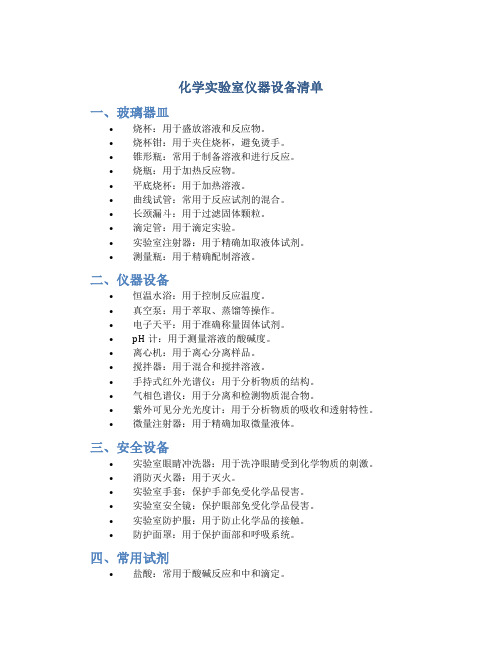
化学实验室仪器设备清单一、玻璃器皿•烧杯:用于盛放溶液和反应物。
•烧杯钳:用于夹住烧杯,避免烫手。
•锥形瓶:常用于制备溶液和进行反应。
•烧瓶:用于加热反应物。
•平底烧杯:用于加热溶液。
•曲线试管:常用于反应试剂的混合。
•长颈漏斗:用于过滤固体颗粒。
•滴定管:用于滴定实验。
•实验室注射器:用于精确加取液体试剂。
•测量瓶:用于精确配制溶液。
二、仪器设备•恒温水浴:用于控制反应温度。
•真空泵:用于萃取、蒸馏等操作。
•电子天平:用于准确称量固体试剂。
•pH计:用于测量溶液的酸碱度。
•离心机:用于离心分离样品。
•搅拌器:用于混合和搅拌溶液。
•手持式红外光谱仪:用于分析物质的结构。
•气相色谱仪:用于分离和检测物质混合物。
•紫外可见分光光度计:用于分析物质的吸收和透射特性。
•微量注射器:用于精确加取微量液体。
三、安全设备•实验室眼睛冲洗器:用于洗净眼睛受到化学物质的刺激。
•消防灭火器:用于灭火。
•实验室手套:保护手部免受化学品侵害。
•实验室安全镜:保护眼部免受化学品侵害。
•实验室防护服:用于防止化学品的接触。
•防护面罩:用于保护面部和呼吸系统。
四、常用试剂•盐酸:常用于酸碱反应和中和滴定。
•硫酸:常用于脱水和催化反应。
•氢氧化钠:常用于酸碱中和反应。
•碳酸氢钠:常用于调节溶液的酸碱度。
•硝酸银:常用于检测氯离子。
•碘酸钾:常用于滴定反应。
•乙醇:常用于溶解固体试剂。
•硫脲酸:常用于检测二价阳离子。
以上仅为化学实验室常用的一部分仪器设备和试剂清单,根据实验需要还可以配备其他专用的仪器设备和试剂。
化学实验室中使用这些仪器设备和试剂时应严格遵守实验室安全操作规范,保护自身安全并确保实验准确可靠。
常见化学实验室玻璃仪器

常见化学实验室玻璃仪器一、玻璃仪器分类化学实验常用的仪器中,大部分为玻璃制品和一些瓷质类仪器。
瓷质类仪器包括蒸发皿、布氏漏斗、瓷坩埚、瓷研钵等。
玻璃仪器种类很多,按用途大体可分为容器类、量器类和其他仪器类。
容器类包括试剂瓶、烧杯、烧瓶等。
根据它们能否受热又可分为可加热的仪器和不宜加热的仪器。
量器类有量筒、移液管、滴定管、容量瓶等。
量器类一律不能受热。
其他仪器包括具有特殊用途的玻璃仪器,如冷凝管、分液漏斗、干燥器、分馏柱、砂芯漏斗、标准磨口玻璃仪器等。
标准磨口玻璃仪器,是具有标准内磨口和外磨口的玻璃仪器。
标准磨口是根据国际通用技术标准制造的,国内已经普遍生产和使用。
使用时根据实验的需要选择合适的容量和口径。
相同编号的磨口仪器,它们的口径是统一的,连接是紧密的,使用时可以互换,用少量的仪器可以组装多种不同的实验装置,通常应用在有机化学实验中。
目前常用的是锥形标准磨口,其锥度为1:10,即锥体大端直径与锥体小端直径之差:磨面锥体的轴向长度为1:10。
根据需要,标准磨口制作成不同的大小。
通常以整数数字表示标准磨口的系列编号,这个数字是锥体大端直径(以mm为单位)最接近的整数。
常用标准磨口系列见表1。
表1常用标准磨口系列有时也用D/H两个数字表示标准磨口的规格,如14/23,即大端直径为14.5mm,锥体长度为23mm。
二、常见的玻璃仪器化学实验室常用的玻璃仪器的主要用途及使用注意事项。
试管规格及表示方法:烧杯规格及表示方法:玻璃质。
以容积(mL)表示,如硬质烧杯400mL。
有一般型、高型;有刻度和无刻度几种。
一般用途:1、反应容器,尤其在反应物较多时用,易混合均匀。
2、也用作配制溶液时的容器或简易水浴的盛水器。
使用方法及注意事项:1、反应液体不能超过烧杯用量的2/3。
2、加热时放在石棉网上,使受热均匀。
刚加热后不能直接置于桌面上,应垫以石棉网。
容量瓶规格及表示方法:移液管规格及表示方法:a酸式滴定管 b碱式滴定管规格及表示方法:洗气瓶规格及表示方法:干燥器规格及表示方法:冷凝管规格及表示方法:比色管规格及表示方法:滴瓶规格及表示方法:培养皿规格及表示方法:称量瓶规格及表示方法:三、玻璃仪器的洗涤1、洗涤液的选择洗涤玻璃仪器时,应根据实验要求、污物的性质及玷污程度,合理选用洗涤液。
常用实验玻璃仪器名称和用途
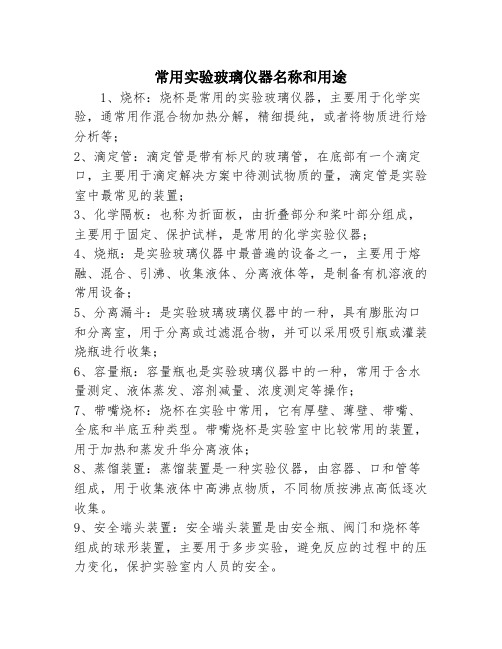
常用实验玻璃仪器名称和用途
1、烧杯:烧杯是常用的实验玻璃仪器,主要用于化学实验,通常用作混合物加热分解,精细提纯,或者将物质进行焓分析等;
2、滴定管:滴定管是带有标尺的玻璃管,在底部有一个滴定口,主要用于滴定解决方案中待测试物质的量,滴定管是实验室中最常见的装置;
3、化学隔板:也称为折面板,由折叠部分和桨叶部分组成,主要用于固定、保护试样,是常用的化学实验仪器;
4、烧瓶:是实验玻璃仪器中最普遍的设备之一,主要用于熔融、混合、引沸、收集液体、分离液体等,是制备有机溶液的常用设备;
5、分离漏斗:是实验玻璃玻璃仪器中的一种,具有膨胀沟口和分离室,用于分离或过滤混合物,并可以采用吸引瓶或灌装烧瓶进行收集;
6、容量瓶:容量瓶也是实验玻璃仪器中的一种,常用于含水量测定、液体蒸发、溶剂减量、浓度测定等操作;
7、带嘴烧杯:烧杯在实验中常用,它有厚壁、薄壁、带嘴、全底和半底五种类型。
带嘴烧杯是实验室中比较常用的装置,用于加热和蒸发升华分离液体;
8、蒸馏装置:蒸馏装置是一种实验仪器,由容器、口和管等组成,用于收集液体中高沸点物质,不同物质按沸点高低逐次收集。
9、安全端头装置:安全端头装置是由安全瓶、阀门和烧杯等组成的球形装置,主要用于多步实验,避免反应的过程中的压力变化,保护实验室内人员的安全。
基础化学实验室仪器设备一览表
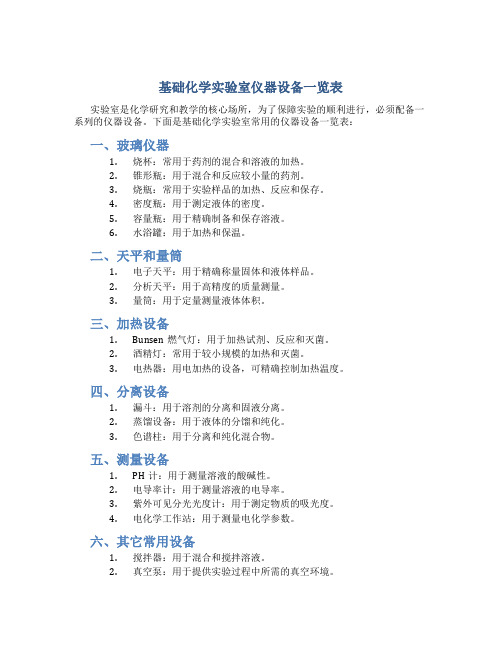
基础化学实验室仪器设备一览表实验室是化学研究和教学的核心场所,为了保障实验的顺利进行,必须配备一系列的仪器设备。
下面是基础化学实验室常用的仪器设备一览表:一、玻璃仪器1.烧杯:常用于药剂的混合和溶液的加热。
2.锥形瓶:用于混合和反应较小量的药剂。
3.烧瓶:常用于实验样品的加热、反应和保存。
4.密度瓶:用于测定液体的密度。
5.容量瓶:用于精确制备和保存溶液。
6.水浴罐:用于加热和保温。
二、天平和量筒1.电子天平:用于精确称量固体和液体样品。
2.分析天平:用于高精度的质量测量。
3.量筒:用于定量测量液体体积。
三、加热设备1.Bunsen燃气灯:用于加热试剂、反应和灭菌。
2.酒精灯:常用于较小规模的加热和灭菌。
3.电热器:用电加热的设备,可精确控制加热温度。
四、分离设备1.漏斗:用于溶剂的分离和固液分离。
2.蒸馏设备:用于液体的分馏和纯化。
3.色谱柱:用于分离和纯化混合物。
五、测量设备1.PH计:用于测量溶液的酸碱性。
2.电导率计:用于测量溶液的电导率。
3.紫外可见分光光度计:用于测定物质的吸光度。
4.电化学工作站:用于测量电化学参数。
六、其它常用设备1.搅拌器:用于混合和搅拌溶液。
2.真空泵:用于提供实验过程中所需的真空环境。
3.显微镜:用于观察和分析微观结构。
以上仅列出了基础化学实验室常用的仪器设备,实验室根据具体研究和教学需要,可能还会配备其他仪器设备。
同时,在使用这些仪器设备的过程中,需要遵循实验室安全操作规程,确保实验过程的安全性和准确性。
希望以上信息对于化学实验室的仪器设备了解有所帮助!。
高中化学实验室仪器设备有哪些
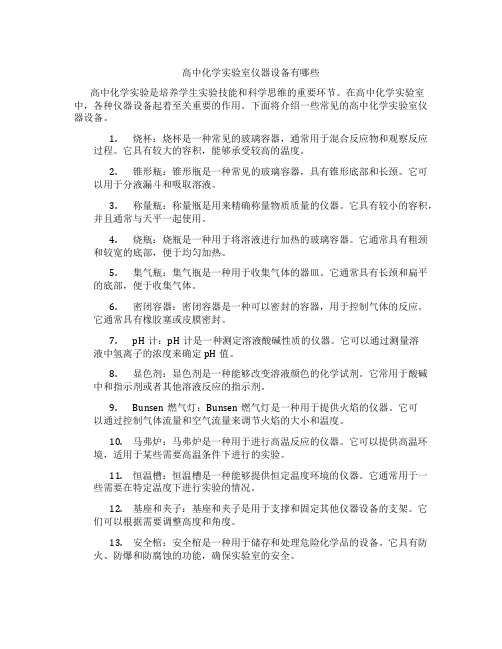
高中化学实验室仪器设备有哪些高中化学实验是培养学生实验技能和科学思维的重要环节。
在高中化学实验室中,各种仪器设备起着至关重要的作用。
下面将介绍一些常见的高中化学实验室仪器设备。
1.烧杯:烧杯是一种常见的玻璃容器,通常用于混合反应物和观察反应过程。
它具有较大的容积,能够承受较高的温度。
2.锥形瓶:锥形瓶是一种常见的玻璃容器,具有锥形底部和长颈。
它可以用于分液漏斗和吸取溶液。
3.称量瓶:称量瓶是用来精确称量物质质量的仪器。
它具有较小的容积,并且通常与天平一起使用。
4.烧瓶:烧瓶是一种用于将溶液进行加热的玻璃容器。
它通常具有粗颈和较宽的底部,便于均匀加热。
5.集气瓶:集气瓶是一种用于收集气体的器皿。
它通常具有长颈和扁平的底部,便于收集气体。
6.密闭容器:密闭容器是一种可以密封的容器,用于控制气体的反应。
它通常具有橡胶塞或皮膜密封。
7.pH计:pH计是一种测定溶液酸碱性质的仪器。
它可以通过测量溶液中氢离子的浓度来确定pH值。
8.显色剂:显色剂是一种能够改变溶液颜色的化学试剂。
它常用于酸碱中和指示剂或者其他溶液反应的指示剂。
9.Bunsen燃气灯:Bunsen燃气灯是一种用于提供火焰的仪器。
它可以通过控制气体流量和空气流量来调节火焰的大小和温度。
10.马弗炉:马弗炉是一种用于进行高温反应的仪器。
它可以提供高温环境,适用于某些需要高温条件下进行的实验。
11.恒温槽:恒温槽是一种能够提供恒定温度环境的仪器。
它通常用于一些需要在特定温度下进行实验的情况。
12.基座和夹子:基座和夹子是用于支撑和固定其他仪器设备的支架。
它们可以根据需要调整高度和角度。
13.安全棺:安全棺是一种用于储存和处理危险化学品的设备。
它具有防火、防爆和防腐蚀的功能,确保实验室的安全。
以上是一些常见的高中化学实验室仪器设备,每个仪器设备在不同的实验过程中都有特定的作用和用途。
熟悉这些仪器设备的使用和操作方法对于进行高中化学实验非常重要。
化学实验室中的玻璃仪器

化学实验室中的玻璃仪器玻璃仪器在化学实验室中扮演着至关重要的角色。
它们通过提供可靠和安全的实验条件,帮助我们进行精确的化学实验。
玻璃仪器具有许多独特的性质,使其成为化学研究和实验的理想选择。
本文将介绍一些常见的玻璃仪器及其用途。
1. 烧杯烧杯是实验室中最基本的玻璃仪器之一。
它通常用于容纳化学试剂,并在化学反应中起到混合反应物和观察反应过程的作用。
烧杯有不同大小的选择,以适应各种容量的试剂。
2. 烧瓶烧瓶是另一个常见的玻璃仪器,它具有圆底或平底。
它们通常用于加热反应物,因为它们能够承受高温。
烧瓶也可用于设置反应过程中的蒸馏装置。
3. 显微镜片显微镜片是一种薄而透明的玻璃片,用于观察显微镜下的物体。
它们用于制备显微镜样本,并帮助我们观察和研究微小的生物和物质。
4. 密度瓶密度瓶是一种精确测量液体密度的玻璃仪器。
它们是由具有标定刻度的细长颈部和封闭盒组成。
通过测量液体在一定条件下的体积和质量,可以计算出其密度。
5. 滴定管滴定管是一种量取和移液的常用工具。
它们通常由细长的玻璃管制成,一端封闭为吸液端,一端连接橡胶管制成滴定管。
6. 集气瓶集气瓶是在实验室中收集气体样品的玻璃容器。
它们通常具有特殊形状的开口,可以用橡胶塞或玻璃管与气体源相连接。
7. 显色管显色管用于观察和测量化学反应过程中的颜色变化。
它们是细长的玻璃管,通常与滴定管或移液管一起使用。
8. 温度计温度计是一种用于测量温度的玻璃仪器。
它们通常包含一个细长的玻璃管,并且在管内含有一种可膨胀的物质,随着温度的变化而导致液体上升或下降。
以上只是一些常见的玻璃仪器示例,实际上化学实验室中还有许多其他类型的玻璃仪器,如试管、移液管和分液漏斗等,它们各自具有独特的功能和用途。
总之,玻璃仪器在化学实验室中是不可或缺的。
它们提供了可靠和安全的实验环境,帮助实验人员进行精确的化学实验,并获得准确的结果。
熟悉和正确使用玻璃仪器不仅是化学实验室操作的基本要求,也是培养实验技能和安全意识的重要环节。
- 1、下载文档前请自行甄别文档内容的完整性,平台不提供额外的编辑、内容补充、找答案等附加服务。
- 2、"仅部分预览"的文档,不可在线预览部分如存在完整性等问题,可反馈申请退款(可完整预览的文档不适用该条件!)。
- 3、如文档侵犯您的权益,请联系客服反馈,我们会尽快为您处理(人工客服工作时间:9:00-18:30)。
常见化学实验室玻璃仪器Chemical laboratory glassware is a common tool used in scientific research and chemical experiments. With the help of these glassware instruments, chemists can carry out various operations with precision and accuracy. In this article, we will introduce the most commonly used chemical laboratory glassware and their functions.1. Erlenmeyer Flask (锥形瓶)The Erlenmeyer flask, also known as a conical flask, is a commonly used glassware instrument in chemical laboratories. It has a cone-shaped bottom and a narrow neck. The wide base of the flask provides stability during stirring and mixing, while the narrow neck allows for easy pouring and reduces thepossibility of spills.The Erlenmeyer flask can be used for a variety of purposes, such as holding, mixing, heating, andboiling liquids. It is ideal for use with solutions that need to be swirled or mixed, as its shape makesit easy to agitate the contents.2. Beaker (烧杯)A beaker is a cylindrical-shaped glassware instrument with a flat bottom and a spout for pouringliquids. It is commonly used in chemical experiments for measuring or mixing liquids.Beakers come in a range of sizes, from small to large volumes, and are often graduated for easy measurement. They are also often used for heating solutions on a hot plate.3. Test Tube (试管)A test tube is a small, thin glass tube used in chemical experiments. It is typically cylindrical in shape with a rounded bottom and an open top. Some test tubes come with a stopper or a cap to seal the contents.Test tubes are often used for holding and mixing small amounts of liquids, as well as for conducting small-scale experiments. They are ideal for heating small amounts of solutions in a water bath.4. Graduated Cylinder (量筒)A graduated cylinder is a cylindrical-shaped glassware instrument with a narrow neck and a flat base. It is mainly used for measuring liquids in chemical experiments.The cylinder is designed with markings along the side, allowing for precise measurement of the volume of liquid it contains. It is often used in conjunction with a pipette or burette for precise measurement of liquids.5. Burette (分液漏斗)A burette is a long and narrow glasswareinstrument that is used for delivering solution to a reaction mixture in a controlled and precise manner.It is often used in titration experiments.Burettes are typically long, thin, and graduated with markings indicating the volume of solution that has been dispensed. It is also equipped with astopcock at the bottom to control the flow of solution.6. Pipette (移液管)A pipette is a thin glass tube with a narrow, tapered tip used for measuring and transferringliquids in chemical experiments. It is also used when very precise and accurate measurements of fluid volume are required.There are two types of pipettes: volumetric and micropipette. Volumetric pipettes are used for measuring a precise volume of solution, while micropipettes are used for measuring very small volumes of liquids.7. Funnel (漏斗)A funnel is a glass cone-shaped instrument thatis used to channel liquids or fine-grained materials into a container with a small opening. It is commonly used in filtration experiments to transfer a liquid from one flask to another.Funnels are also used in decanting experiments, where a liquid is slowly poured off a precipitate, andin separating the different layers of immiscible liquids.8. Petri Dish (培养皿)A Petri dish is a small, shallow glassware instrument that is used for the culturing of microorganisms, such as bacteria and fungi. It is often used in microbiology experiments.Petri dishes are made with a lid to prevent contamination of the culture media inside. They are also equipped with a flat bottom to help spread the culture media evenly.9. Watch Glass (蒸发皿)A watch glass is a circular-shaped glassware instrument with a flat bottom and a slightly curved top. It is mainly used for evaporation experiments and to hold small quantities of solids.Watch glasses are often used to cover evaporating dishes to prevent dust or other contaminants from entering or to heat small amounts of liquid over a Bunsen burner.10. Thermometer (温度计)A thermometer is a glassware instrument used for measuring the temperature of liquids or gases in chemical experiments. It is available in both analog and digital forms.Thermometers are typically made with a long, skinny glass bulb filled with a liquid, usuallymercury or alcohol. As the temperature increases, the liquid expands and rises in the thin, calibrated tube. The temperature is read off the scale marked on the glassware instrument.In conclusion, chemical laboratory glassware is an essential tool in scientific research and chemical experiments. Each instrument has its purpose and is designed for precision and accuracy. It is essential to use the appropriate glassware to ensure accurate and reliable results and to maintain the safety of the experimenters.。
